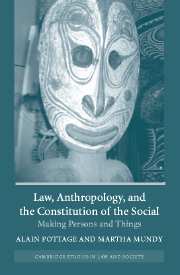Book contents
- Frontmatter
- Contents
- Notes on contributors
- 1 Introduction: the fabrication of persons and things
- 2 Res Religiosae: on the categories of religion and commerce in Roman law
- 3 Scientific objects and legal objectivity
- 4 Legal fabrications and the case of ‘cultural property’
- 5 Ownership or office? A debate in Islamic Hanafite jurisprudence over the nature of the military ‘fief’, from the Mamluks to the Ottomans
- 6 Gedik: a bundle of rights and obligations for Istanbul artisans and traders, 1750–1840
- 7 Losing (out on) intellectual resources
- 8 Re-visualising attachment: an anthropological perspective on persons and property forms
- 9 Our original inheritance
- Bibliography
- Index
9 - Our original inheritance
Published online by Cambridge University Press: 12 July 2009
- Frontmatter
- Contents
- Notes on contributors
- 1 Introduction: the fabrication of persons and things
- 2 Res Religiosae: on the categories of religion and commerce in Roman law
- 3 Scientific objects and legal objectivity
- 4 Legal fabrications and the case of ‘cultural property’
- 5 Ownership or office? A debate in Islamic Hanafite jurisprudence over the nature of the military ‘fief’, from the Mamluks to the Ottomans
- 6 Gedik: a bundle of rights and obligations for Istanbul artisans and traders, 1750–1840
- 7 Losing (out on) intellectual resources
- 8 Re-visualising attachment: an anthropological perspective on persons and property forms
- 9 Our original inheritance
- Bibliography
- Index
Summary
In May 2000, two parliamentary members of the Council of Europe, Jean-François Mattei and Wolfgang Wodarg, organised an Internet petition which invited concerned individuals to protest against the implementation of the European Union's 1998 Directive on the Legal Protection of Biotechnological Inventions. This was the Directive which, according to its critics, effectively authorised the patenting of ‘human’ gene sequences. Signatories were asked to write to Romano Prodi, then the President of the European Union, affirming the proposition that ‘the human genome is the common patrimony of humanity’, and requesting that ‘the granting of patents on the genome be suspended’. By the time it was submitted, in November 2000, the petition had apparently attracted some 10,000 signatures, mainly from France. It included the names of prominent geneticists such as the Nobel laureates Jean Dausset and François Jacob. President Chirac also expressed his adherence to the petition, but his support was somewhat equivocal, being based less on the recognition of the special prestige of life or biology than on the pragmatic argument that the patents system might be stifled: ‘trop de brevets tuent le brevet’.
The theme of genetic inheritance now infuses so many dimensions of life, from the personal experience of health to the functioning of social institutions such as employment and insurance, that it has become essential to many contemporary forms of self-understanding.
- Type
- Chapter
- Information
- Law, Anthropology, and the Constitution of the SocialMaking Persons and Things, pp. 249 - 285Publisher: Cambridge University PressPrint publication year: 2004
- 2
- Cited by

